Multi 50 capsize in Transat Jacques Vabre
Published on November 9th, 2017
(November 9, 2017; Day 5) – The 13th edition of the Transat Jacques Vabre now has 35 crews in the four classes (Ultime, Multi 50, Imoca, Class40) left racing following the abandonment today of Halvard Mabire and Britain’s Miranda Merron on their Class40 Campagne de France and the capsizing last night of the Multi50 Drekan Groupe.
Eric Defert and Christopher Pratt, the two French sailors trapped on the overturned Drekan Groupe overnight, are safe and sound after being rescued by the crew of the Dutch cargo ship, Beautriton, this morning. They are now heading for Georgetown, USA, instead of the finish line in Salvador de Bahia, Brazil.
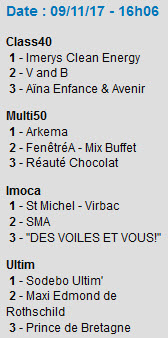 It was a sobering day of this bi-annual double-handed Route du café, tracing the historic coffee trade route from Le Havre. The hectic pace set by the leaders, the chaotic sea and the violent squalls are making enormous demands on the boats and the sailors.
It was a sobering day of this bi-annual double-handed Route du café, tracing the historic coffee trade route from Le Havre. The hectic pace set by the leaders, the chaotic sea and the violent squalls are making enormous demands on the boats and the sailors.
Sodebo Ultim’ has taken the lead from Maxi Edmond de Rothschild in the Ultime class as Thomas Coville and Jean-Luc Nélias’s decision to position themselves further west paid in stunning fashion as they turned a 70-mile deficit into a 60 mile lead. Sébastien Josse and Thomas Rouxel were forced to gybe last night and are sailing in Sodebo Ultim’s wake. Ominously, the newly-launched Maxi Edmond de Rothschild had already eaten back 10 miles of that advantage yesterday afternoon, averaging 28 knots to their rivals 20.
In the Imoca, the favourite, St Michel-Virbac, was maintaining its lead, but even more impressive was the incredible SMA, who are still somehow in second just 30 miles behind in an old boat without foils. In the Multi 50 the fight is getting ever fiercer between Arkema and FenêtréA-Mix Buffet, who have opened up a gap of 150 miles on the rest.
In the Class40, the Anglo-Spanish duo of Phil Sharp and Pablo Santurde (Imerys Clean Energy) has been setting a speed that has been punishing his French rivals in newer boats and matching the older boats at the back of the Imoca 60 fleet. Only V and B have matched them and are 30 miles behind, making a spectacular comeback after having to slow and laminate a cracked forward bulkhead yesterday.
Capsize
The capsize of the 50ft trimaran Drekan Groupe in the North Atlantic occurred just before 21:00 UTC last night (full report).French sailors, Eric Defert and Christopher Pratt, offer this report from the Dutch cargo ship, Beautriton:
“We were sailing downwind under one reef with the little gennaker. We were going to roll up the little gennaker. I was below and Chris (Christopher Pratt) was on deck. I was preparing to go out, to take in another reef. The boat pitchpoled, (plunging forward and flipping over). It was blowing hard, we were under a squall in a pitch-black night, but we were being very cautious. Chris just got inside. I was below, so that’s ok, but when you’re on deck it’s less easy. There was a huge feeling of shock. You blame yourself; there are no words. Our rescuers arrived in the area at half past midnight. They circled around us all night; they did a great job. The rescue was epic because there was a lot of sea and wind. Their boat only had a small 15hp engine. They came to save us, and we found out that one of them was having a birthday. So, maybe his gift was saving two lives.”
Abandons
Mabire and Merron on Campagne de France (Class40) arrived in their home port of Cherbourg at 11:30 UTC and officially declared their abandonment to the race office, following serious damage to their port rudder on Tuesday.
Forced stopover
Enel Green Power, skippered by Italians, Andrea Fantini and Alberto Bona are heading to Lisbon to try and fix their starboard rudder (bracket or bearing). They recovered the rudder, but there is a big hole in the stern at the level of the rudder attachment.
Back to business
The Ultime, Prince de Bretagne, left the island of Santa Maria in the south of the archipelago of the Azores at around noon. After a mast climb, Bernard Stamm and Lionel Lemonchois were able to solve their mainsail halyard problem.
Slamming on the brakes
A mini-Doldrums tomorrow before the real thing looks like causing a headache for the two giant trimarans at the front as they pass the half-way mark and approach the latitude of the Cape Verde islands. As forecast, the stationary depression in the southern part of the Canaries is disrupting the trade winds.
Mind the squalls
For the Multi50, Imoca and Class40 the wet, wild gusts and battering seas are not over yet. “We’re all on fire,” Alexis Loison, co-skipper of Class40 Carac, said. “At the moment, we are under a spinnaker with 2 reefs in the mainsail and we’re doing 18 knots.” Erwan Le Roux on his Multi50, FenêtréA – Mix Buffet, said that the atmosphere was like a dizzying black run descent. Tomorrow the conditions should begin to improve. DIY and napping will be on the schedule.
Keels are nice
“My thoughts are with the Multi 50 guys and hats off to all of them because these conditions are really hard and it’s hard enough for us (in an Imoca 60 monohull) and we’ve got a keel underneath our boat that keeps us the right way up,” said Samantha Davies, co-skipper Iniatives-Cœeur (Imoca).
“But there’s been a couple of times with Tanguy and I when we’ve put our boat on its side with various manoeuvres or just trying to push it too hard. But our boat comes back upright when tips over on its side, it’s not the same for a Multi 50. It’s loud because we’re doing 29 knots. The speed were doing is absolutely ridiculous, so the gaps in terms of time are only a matter of an hour or two. So, it’s really still pretty close.”
Race details – Entry list – Tracker – Facebook
13th edition of the Transat Jacques Vabre
• Biennial doublehanded race now 24 years old
• Two founding partners: the city of Le Havre and brand Jacques Vabre
• Four classes on the starting line: Class40, IMOCA, Multi50, and Ultimate
• Starting November 5 in Le Havre (FRA) for the 4350nm course to Salvador de Bahia (BRA)
n 2013, and again in 2015, all the boats flew past Salvador de Bahia, sails filled by the trade winds of the south-east, under the tropical sun…One imagines that they dreamt of finally finishing their race in All Saints’ Bay. In 2017, it will be a reality!
After the start line and a coastal route as far as Etretat, the duos will head towards Brittany to get out of the Channel as quickly as possible, where the currents are powerful, cargo traffic dangerous, and a lot of attention is needed.
They will then enter the Bay of Biscay, where, depending on the position of the Azores anticyclone, they will either find downwind conditions, easy and fast, like for the last Vendée Globe, or tougher and slower conditions in the passage of some late autumn depressions.
Four hundred miles later, having passed Cape Finisterre, the northern Portuguese trade winds should propel them quickly towards Madeira, and then the Canary Islands, where awaiting them will be northeast trade winds, which could be strong or weak.
Passing close to the Portuguese coast, or offshore, to the east or west of the Canary Islands and then the Cape Verde islands – you have to choose the right options. The next goal is to establish your position for the crossing of the dreaded Doldrums, located a few degrees north of the equator. At this time of year, it can change position very quickly, extend or contract, because even after carefully studying of the satellite images, sudden squalls can develop and stall the competitors under a good shower without wind for hours.
This passage is crucial in the Transat Jacques Vabre racecourse. Further west… Further east… After the calms, rainy squalls, with too much or no wind… The final goal is to get out well-positioned enough to benefit first from the southeast trade winds and to cover the remaining 850 miles towards the finish,passing along the islands of Fernando de Noronha, along the coast of Brazil and finally heading northwest into the magnificent All Saints’ Bay.
This transoceanic racecourse from North to South is more demanding than a transat from East to West; it requires the skippers to have sharp tactical and strategic qualities, good weather training, to be in excellent physical condition to maintain a sustained speed in the trade winds… And to have a lot of patience to cross the equator.
Source: Transat Jacques Vabre


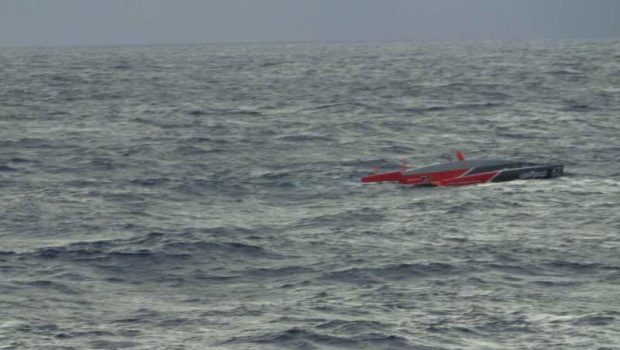

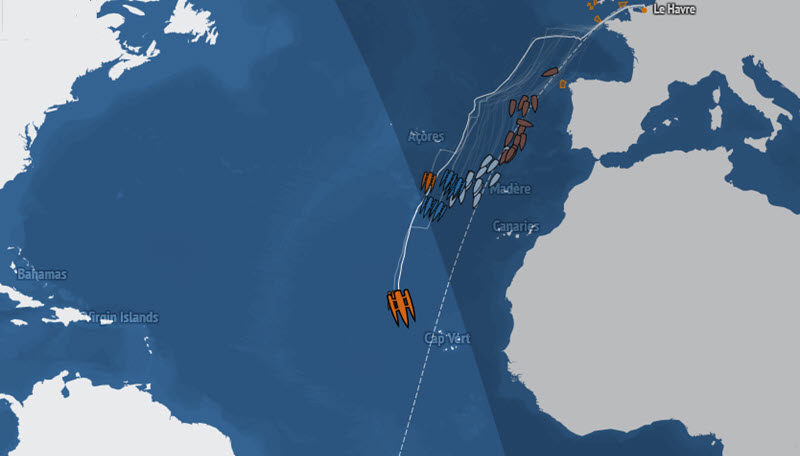
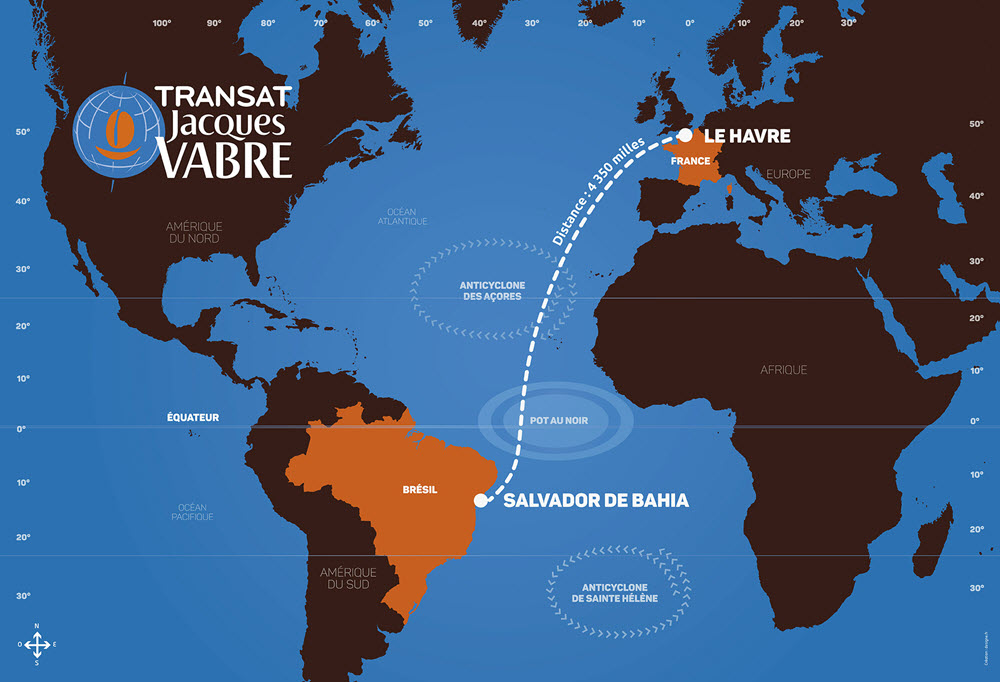

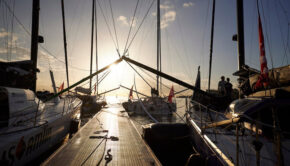
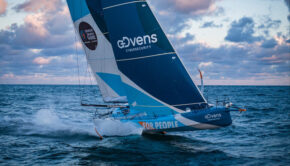
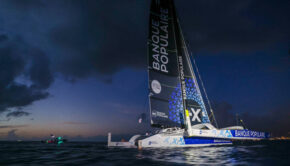
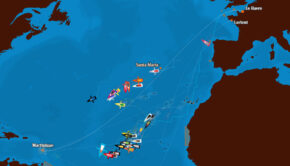
 We’ll keep your information safe.
We’ll keep your information safe.